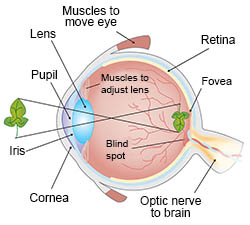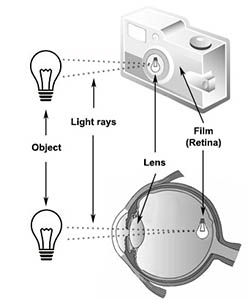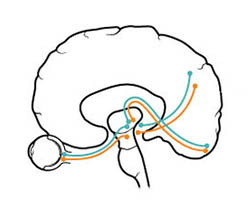
Illustrated by: Gustavo Castaneda
show/hide words to know
How Do We See?
Take a look around you. What do you see? You might see a computer or phone with a shining, colorful screen. A piece of paper may be under your left hand and a sharpened pencil in your right hand. While you look at these objects with your eyes, your brain is what is recognizing the objects. Many people take sight for granted, but how are you able to see and register objects?
You probably already know that your body has five senses that help you experience the world around you. These senses are touch, taste, hearing, smell, and sight. Although all of your senses are important, many people think that sight would be the most difficult one to live without.
If you could not see, how would you watch TV, cook food and not burn yourself, or walk across the street without being hit by a car? Many people do all kinds of activities without being able to see. Let's learn a bit more about how vision works.
The information that some animals receive through their eyes is called “visual information” or “vision.” For now, let's think of the eye as a sort of camera.
How Do Cameras Work?
You and your friends have only been hiking for about an hour, but already, you've probably taken a hundred photos. Up ahead is another perfect opportunity: a brightly colored flower seems to be glowing in the sunlight. You hold your camera up to take a picture.
For your camera to work, light must come in through the lens and reach the back of the camera. When you point the camera at a flower, the sunlight that bounces off the flower enters through the lens. The lens directs the light so that it shines onto the back of the camera.
Light cannot bend and must travel in a straight line. Because the area in the lens where light goes in is very small compared to the size of the object, the light that contains the image will create an upside down and flipped picture. The images that are captured on your retina are also upside down but your brain converts the information so you perceive the world correctly.
So, light enters the camera and the image is flipped. What happens next? Digital cameras have an area with little sensors that are sensitive to light. Sensors will collect the bits of light that come through the camera and organize them to create a picture of the flower.
A picture is actually made from a lot of small squares called pixels. However, because they are so small, you don’t see the individual pixels. When the pixel squares are put together, they will create a picture or photograph you can see.
This picture of a flower is made up of a lot of colored boxes. In the flower on the left, they are so small you cannot see them.
Your eyes work much like a camera. Light bounces off the image in front of you and comes into your eyes through the cornea. The cornea is a clear thin layer on the outside of your eyes. The cornea will help direct the light towards your pupil and Iris. These two parts work together to control the amount of light entering your eye.
The iris is the colored part of your eye and the pupil is the little dark circle in the center of your eye. You may have noticed that sometimes your pupils are bigger and sometimes they are smaller. This is because an iris can shrink and grow, allowing different amounts of light to pass through your pupils. This is like controlling the aperture of a camera.
Once the light comes through the pupil it will go through the eye’s lens. Just like in a camera, the lens is used to focus on an object and direct the light to the back of the eye. The back of the eye is called the retina and it has special sensors called cones and rods. Visual information excites the cone and rod sensors. Cones are involved in seeing color.
Once the cones and rods have been exposed to light, they translate the visual information into electric information. The optic nerve will send this information to your brain. The tiny nerve cells are able to take the electric form of the image in front of you and send it to the brain’s visual cortex or “Vision Center.”
The “Vision Center,” is located in the back part of your brain (the occipital cortex or lobe). It is responsible for decoding the electrical information coming from the retina. The vision center interprets the electric form of the image, allowing you to form a visual map.
As you can SEE, vision is a complex process. The brain has to do a lot of work to make a picture. But what happens if what you see is blurry? Maybe you or someone you know may need to wear glasses or contacts in order to see clearly. You may even know someone who is blind and cannot see at all. How do you think they see the world?
Additional images via Wikimedia Commons. Colored sphere by Theon.
View Citation

You might only experience this sphere image by seeing it, but if it were an object physically in front of you, you could also touch it, smell it, taste it (if you want), and try to listen to it.
Do insects see the same thing you do? Visit insect vision to learn more.
Learn more about our five senses.
Be Part of
Ask A Biologist
By volunteering, or simply sending us feedback on the site. Scientists, teachers, writers, illustrators, and translators are all important to the program. If you are interested in helping with the website we have a Volunteers page to get the process started.












